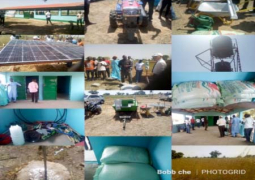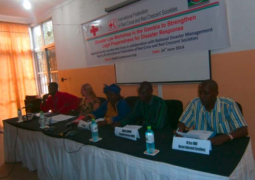Today’s edition of the weekly Environment Column brings environment and environment-related issues to the limelight.
Today, we look at the physical environment in The Gambia and the country’s ecosystem.
According to a research by the Executive Director of Biodiversity Action Journalists The Gambia, The Gambia lies between 13.79o and 16.82o West longitude and entirely within 13o North latitude.
With a surface area of 11,300 km2, the country is bound by Senegal to the North, South and East and by the Atlantic Ocean to the West.
The Gambia is thus a narrow strip of land within Senegal, widest at its westerly end towards the ocean, narrowing to about half this width at its eastern end, 330 km inland.
The country is bisected by the River Gambia, and Banjul is the administrative centre and capital situated on an island on the south bank at the mouth of the river.
The geology of the Gambia is relatively recent from the Tertiary and Quaternary periods. The country is generally low-lying with altitudes mostly below 60 m above sea level. The combination of low-lying topography, poorly drained soils and abundant water provide unique and diverse habitats.
The soils are primarily influenced by the hydrology. In the western third of the country, where the river water is salty or brackish, the soils are clay and alluvium and heavily impregnated with salt.
The only vegetation that thrives in such conditions is mangrove forest. In the freshwater areas, the soils are often light alluvium and are more fertile and these have been used for rice production for centuries.
The Gambia’s climate is characterized by a long dry season from October to early June and a short rainy season from mid-June to early October.
Average annual rainfall ranges from 850 mm to 1,200 mm and average temperatures range from 18 to 33 degrees C.
Relative humidity is around 68 per cent along the coast and 41 per cent inland during the dry season and generally above 70 per cent throughout the country during the wet season.
In the dry season, north easterly winds dominate, resulting in generally cloudless skies and the presence of dust particles in the air.
During the wet season, south westerly monsoon winds, combined with heat on the continent, give rise to the formation of thundery activities, usually accompanied by strong winds, heavy rain and severe lightning.
Climate hazards include torrential rainfall, storms, drought, cold spells, heat waves, intra-seasonal drought and unseasonal rains. Some of these hazards are projected to increase in frequency and intensity, and become more widespread.
Indeed, climate change is prone to becoming a significant barrier to future national development and poverty reduction, and to the achievement of sustainable development goals, because the productive base of the economy depends on climate-sensitive activities such as crop production, livestock rearing, fisheries, forestry (biodiversity), energy, and water resources.
The Gambia is blessed with abundant water resources which comprise seasonal rains, storage in ephemeral ponds and depressions, the River Gambia and two aquifer systems underlying the entire country.
The country is further distinguished by its location in the central part of the coastal sedimentary basin known as the Mauritania-Senegal-Gambia-Guinea-Guinea Bissau Basin which add up to make The Gambia a focal point of extensive regional surface and groundwater systems.
These water resources provide the basis for sustaining life and promoting socioeconomic development.
The River Gambia enters The Gambia around Koina, bisects the country into two narrow strips of land, which vary in width from 48 km at the Atlantic Coast, to 24 km in the eastern region, and continues down westwards to the Atlantic Ocean. Major tributaries include the Sandougou, Nianija, Sofaniama, Miniminiyang, Bao and Bintang bolongs.
The estuary is fully mixed with no evidence of stratification. There is, however, a moving interface separating the saline/brackish water from the freshwater mass along the river.
As a result of seasonal low flows, the interface can shift from a maximum penetration of 250 km upriver in the dry season to less than 100 km upriver in the rainy season.
For agricultural purposes, points along the river with a salt concentration of 1ppt demarcate the salt water / freshwater interface, also referred to as the salt front, or the saline limit.
River ecology is divided into two different zones, estuarine and freshwater, which in turn largely determine the riparian vegetation pattern.
The tidal estuary is fringed with important mangrove stands as well as barren saline flats, mudflats, river banks with brackish and fresh water zones, lagoons, marshes, swamps, and other wetland habitats.
Mangroves dominate the riverside in the lower estuary, and extensive reed belts the in-between zone. In the fresh water zone, the banks are lined with gallery forest.
Groundwater resources are stored in the phreatic aquifer, and the semi-confined aquifer, which are both of Pliocene age. The Shallow Sandstone Aquifer is estimated to hold 125 million m3 of good quality water.
The sandstone aquifer is estimated to hold reserves of good quality water in the order of 80,000 m3. Recharge of the aquifers is mainly by infiltration from rainfall and from lateral flow from Senegal. Groundwater in The Gambia tends to be slightly acidic with pH values mostly ranging from 5.0 to 6.5.
In 2007, The Gambia reached the MDGs target with up to 85.2 per cent of the population having access to safe sources of drinking water. However, demand for water is expected to exceed the available recharge in the shallow aquifer by 2020.
The topography of The Gambia, a major determinant of ecosystems, land cover and land use, reveals several distinct levels or zones: the river with its associated tributaries and river-border mangrove forests; the river’s wetlands and floodplain; the extensive lowlands and colluvial slopes; the upland lower and upper plateaus that extend into Senegal.
The patterns of land use in The Gambia, to a large extent, correspond to the vegetation zones across the country.
The vegetation zones in turn are largely determined by the rainfall patterns of the different parts of The Gambia. In general, the wetter western half of the country including the western parts of the Lower River Region originally had thicker land forest covers with bigger tree species.
The drier hinterlands, especially the north bank of the River Gambia, receive scantier rainfall and are today covered mainly with shrubs and savannah grasses. About one-third of all Gambian land is made up of agricultural lands.
Despite its small size, The Gambia is therefore endowed with rich and varied ecological systems closed and open woodlands, trees and shrub savannah, wetland ecosystems, grassland savannah, offshore islands, marine and coastal ecosystems and agricultural ecosystems.
The present project is focused on ecosystems on either side of the River Gambia, inland from the coastal and estuarine zones but still under some tidal influence. The key ecosystems of interest are forests, wetlands and, to a lesser extent, grasslands.
Terrestrial ecosystems, forests and land use change: Aside from the gallery forests and mangroves that dominate the coastal, estuarine and river-border vegetation, the Gambia today contains a still rich yet impoverished combination of natural and man-made terrestrial ecosystems.
These falls under two major biomes/Ecoregions and four main agro-ecological zones: the relatively moist Guinean Savannah, approximately in the western third of the country, with the Guinean woodlands characterized by broadleaf trees (507 km2m); the drier Sudanian-Savannah, with Sudanian transitional woodlands (2,070 km2); Sudano-Sahelian savannah woodlands, covering 8,035 km²; and Sahelian savannah with open trees, shrubs and grasslands (70 km2).
The status of both these terrestrial ecoregions is considered Critical/Endangered at the supra-national/regional level, and very few stretches remain in a natural state.
This shows the distribution of standing forest/woodland types from 1946 to 1998 (with now out-dated estimates for 2005 and 2015).
Overall, woodland cover in The Gambia progressively decreased from 81 per cent in 1946 to 42 per cent in 1998. The standing volume in open woodland was reduced and the closed woodland began to disappear.
On the other hand, the tree and shrub savannah increased as a result of the extensive conversions and the degradation of the other classes.
According to a second assessment of land use change in the Gambia over recent decades revealed that for woodlands: closed and open woodland were reduced by over 3.1 per cent a year due to forest degradation and conversion into agricultural land.
However, Savannah: forested lands have increased due to a reversion of former agricultural land (mainly fallow land) into secondary tree and shrub savannah and the increased community participation in forest management.
Mangroves: the mangroves have suffered serious die-back since the beginning of the 1970s reducing the total area by more than 10 per cent. This is mainly due to the reduced flushing effect leading to hyper salinity and fungal infections.
Fallow areas: the fallow areas have decreased by almost 4.4 per cent due to conversion into tree and shrub savannah, agriculture with no trees or, to a lesser extent, into agriculture with trees.
Agriculture with trees: the class remained relatively unchanged although a proportion was converted into agriculture with no trees and almost the same proportion was added from fallow areas and woodland.
Agriculture with no trees: the class increased by about 1.3 per cent. Others: the western parts of the country have the highest percentage of land classified ‘others’ with increasing tendency, whereas up-river this category decreases due to migration patterns both internal and external.
Compounding all the above rates of forest cover loss, the cover recorded today includes degraded open savannah woodlands of reduced value for biodiversity and exposed to regular disturbance by humans and livestock while the less accessible closed and open woodlands account for not more than 10 per cent of remaining forest.
During the long dry season, bushfires are a common feature of the rural landscape and more than 70 per cent of the country’s forests and grasslands suffer through such bushfires.
The Lower River Region has the highest incidence of bushfires while the Central River Region and the West Coast Region have a lower incidence probably as a positive result of community participation.
Besides wholesale habitat destruction, constant fires in forest/woodland ecosystems may lead to changes in tree species composition, to assemblages that are more fire tolerant; this change in tree species is changing the habitat and driving dependent wild animals almost to extinction.
For your contributions, suggestions or to be featured please contacts: (+220) 6361340 or Email: asallah6@yahoo.com



